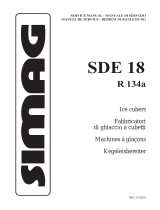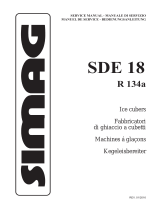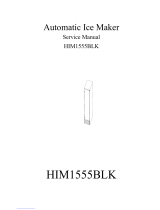
UCG GOURMET SERIES UNDERCOUNTER
pg. 15
The length of the defrost cycle is related to the length of the second phase of the freeze cycle T2.
(Time to drop the evaporating temperature from 32˚F (0˚C) – small red LED blinking – to 5˚F (-15˚C)
small red LED ON steady. It is possible to extend the length of the defrost cycle by changing the setting
of the DIP SWITCH 7 and 8 as shown on the table on page 22.
The electrical components in operation during this phase are the compres sor, water inlet valve, hot
gas valve, and water drain valve.
The incoming water, passing through the water inlet valve and the flow control, runs over the
evaporator plate and then flows by gravity through the dribbler holes down into the sump/reservoir.
(Fig. F and H). The water filling the sump/reservoir forces part of the surplus water from the previous
freeze cycle to go out to the waste through the overflow pipe. This overflow limits the level of the
sump water, which will be used to produce the next batch of ice cubes. Meanwhile, the refrigerant
as hot gas, discharged from the compressor, flows through the hot gas valve directly into the
evaporator serpentine by-passing the condenser. The hot gas circulating into the serpentine of the
evaporator warms up the copper molds, causing the defrost of the ice cubes. The ice cubes, released
from the cups, drop by gravity onto a slanted cube chute, then through a curtained opening they fall
into the storage bin. At the end of the defrost cycle, the hot gas valve, the water inlet valve, and the
water drain valve close and the machine starts again a new freeze cycle.
C. OPERATION – CONTROL SEQUENCE
At the start of the freeze cycle the evaporator temperature sensor controls the length of the first part
of the freeze cycle. As it reaches a predetermined temperature it supplies a low voltage current to
the PC Board in order to activate the electronic timer, which takes over the control of the freeze cycle
for a pre-fixed time, according to the DIP SWITCH keys setting (see Tab. B).
The evaporator temperature sensor, factory pre-set, is the same for all the models and is not
adjustable in the field.
Once the freeze cycle is completed, the system goes automatically into the defrost cycle which has
also a pre-fixed length. At completion of the defrost cycle, the PC Board commands the unit to start
again a new freeze cycle.
D. OPERATION – ELECTRICAL SEQUENCE
The following charts illustrate which switches and which components are ON or OFF during a
particular phase of the ice making cycle. Refer to the wiring diagram for a reference.
1. BEGINNING FREEZE
NOTE: In case the unit is able to reach 32˚F (0˚C) evaporating temperature
within 15 minutes, but after 45 minutes from the beginning of the freeze cycle
it has not yet reached the evaporator temperature of 5˚F (-15˚C), the machine
goes straight into the defrost cycle omitting the timed portion of the freeze
cycle per the setting of the first four DIP SWITCHES.
























